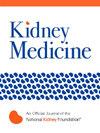Utilization Trends of Dual GIP/GLP-1 Receptor Agonist, Newer Glucose-Lowering Medications, and Anti-Obesity Medications Among Patients With Chronic Kidney Disease With and Without Type 2 Diabetes
IF 3.4
Q1 UROLOGY & NEPHROLOGY
引用次数: 0
Abstract
Rationale & Objective
Tirzepatide, a dual GIP/GLP-1 receptor agonist, has been approved for type 2 diabetes (T2D) and obesity. However, the real-world utilization of tirzepatide remains unexplored, particularly in patients with chronic kidney disease (CKD), where the prevalence of T2D and obesity is high. This study aimed to describe the utilization trends of tirzepatide, glucose-lowering medications (GLMs), and anti-obesity medications (AOMs) in patients with CKD, with and without T2D.
Study Design
A population-based, observational cohort study.
Setting & Participants
Patients with CKD, with and without T2D, were identified from a large US health insurance claims database (from January 1, 2022 to September 30, 2023).
Exposures
Tirzepatide, other GLMs, and AOMs.
Outcomes
Medication utilization trends and patient characteristics. Any users were defined as those with prescription claims, and incident users as those with no previous dispensing within 365 days.
Analytical Approach
Longitudinal trends were assessed by 1-month intervals from January 1, 2022 to September 30, 2023.
Results
Among 455,047 patients with CKD and T2D, tirzepatide any users increased to 4.8% in September 2023, while incident users rose from 0.8% to 8.6%. Sodium glucose cotransporter-2 inhibitors remained the most initiated GLM. Tirzepatide initiators had higher rates of obesity (32.5%), and morbid obesity (44.1%) when compared with other GLMs. Among 5,978 patients with CKD without diabetes, weekly semaglutide ≤2 mg was the most initiated AOM, followed by tirzepatide. Incident users of tirzepatide rose from 0.6% in June 2022 to 23.5% in September 2023. Clinical characteristics were similar between semaglutide ≤2 mg versus tirzepatide initiators.
Limitations
The study period ended before tirzepatide’s approval for weight management (November 2023).
Conclusions
Our study indicates rapidly shifting trends in tirzepatide uptake among patients with CKD both with and without diabetes. The uptake of tirzepatide is expected to increase further. Future studies on the comparative effectiveness and safety of tirzepatide in patients with CKD are warranted.
Plain Language Summary
Tirzepatide, a dual GIP/GLP-1 receptor agonist, has been approved for glycemic control and weight management, but its utilization in the real-world settings among patients with chronic kidney disease (CKD) is unknown, where the prevalence of type 2 diabetes and obesity is high. In this study, we examined the utilization trends of tirzepatide, other glucose-lowering medications, and anti-obesity medications (AOMs) from January 1, 2022 to September 30, 2023 using a large US health insurance database. We found that the use of tirzepatide has been rapidly rising as a GLM and AOM among patients with CKD and is expected to increase further. Future studies on the effectiveness and safety of tirzepatide against other glucose-lowering medications or AOMs in patients with CKD are needed.
双重GIP/GLP-1受体激动剂、新型降糖药物和抗肥胖药物在合并和不合并2型糖尿病的慢性肾病患者中的应用趋势
基本原理及tirzepatide是一种双GIP/GLP-1受体激动剂,已被批准用于治疗2型糖尿病(T2D)和肥胖症。然而,替西帕肽在现实世界中的应用仍未被探索,特别是在慢性肾脏疾病(CKD)患者中,其中T2D和肥胖的患病率很高。本研究旨在描述替西帕肽、降血糖药物(GLMs)和抗肥胖药物(AOMs)在伴有和不伴有T2D的CKD患者中的使用趋势。研究设计一项基于人群的观察性队列研究。设置,从美国大型健康保险索赔数据库(从2022年1月1日至2023年9月30日)中确定CKD患者,伴或不伴T2D。暴露替西肽,其他glm和AOMs。结果:药物使用趋势和患者特征。任何用户被定义为有处方索赔的用户,事件用户被定义为在365天内没有先前配药的用户。从2022年1月1日至2023年9月30日,每隔1个月对纵向趋势进行评估。结果在455,047例CKD和T2D患者中,替西帕肽的使用者在2023年9月增加到4.8%,而意外使用者从0.8%上升到8.6%。钠葡萄糖共转运蛋白-2抑制剂仍然是最开始的GLM。与其他glm相比,替西肽启动剂的肥胖率(32.5%)和肥胖率(44.1%)更高。在5978例无糖尿病的CKD患者中,每周西马鲁肽≤2 mg是最开始的AOM,其次是替西帕肽。替西肽的意外使用者从2022年6月的0.6%上升到2023年9月的23.5%。西马鲁肽≤2mg与替西帕肽起始剂的临床特征相似。研究期在替西帕肽被批准用于体重管理(2023年11月)之前结束。结论:我们的研究表明,无论是合并还是不合并糖尿病的CKD患者,替西肽的摄取趋势都在迅速变化。替西帕肽的摄取预计将进一步增加。需要进一步研究替西帕肽在慢性肾病患者中的相对有效性和安全性。tirzepatide是一种双GIP/GLP-1受体激动剂,已被批准用于血糖控制和体重管理,但其在慢性肾脏疾病(CKD)患者中的实际应用尚不清楚,其中2型糖尿病和肥胖的患病率很高。在这项研究中,我们使用一个大型美国健康保险数据库,研究了2022年1月1日至2023年9月30日期间替西帕肽、其他降糖药物和抗肥胖药物(AOMs)的使用趋势。我们发现,在CKD患者中,替西帕肽作为GLM和AOM的使用正在迅速增加,并有望进一步增加。在CKD患者中,替西帕肽对其他降糖药物或AOMs的有效性和安全性有待进一步研究。
本文章由计算机程序翻译,如有差异,请以英文原文为准。
求助全文
约1分钟内获得全文
求助全文

 求助内容:
求助内容: 应助结果提醒方式:
应助结果提醒方式:


